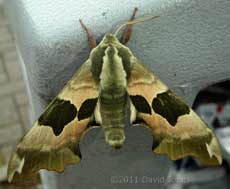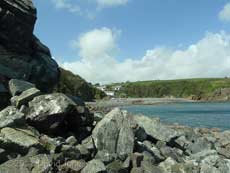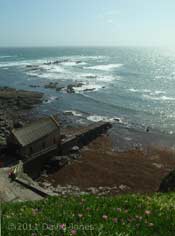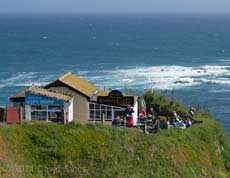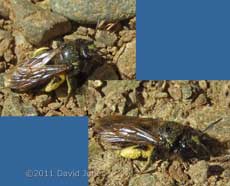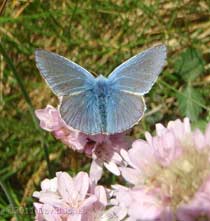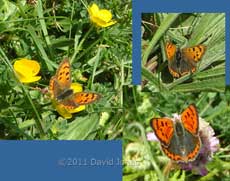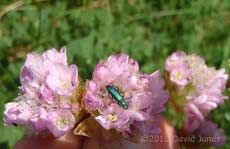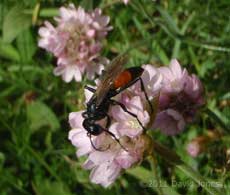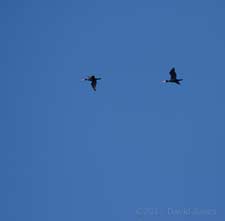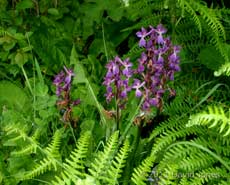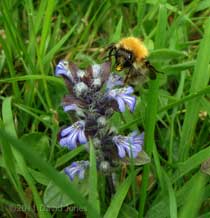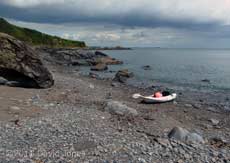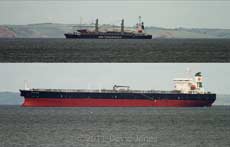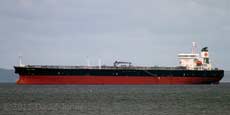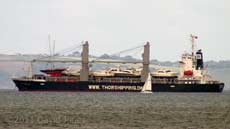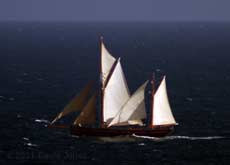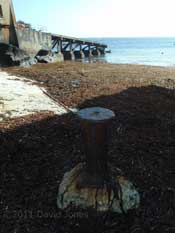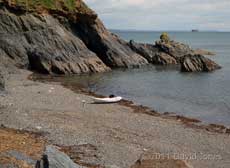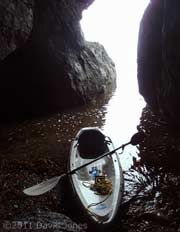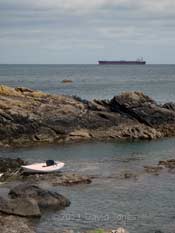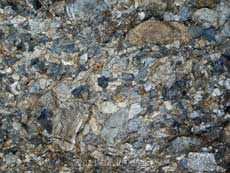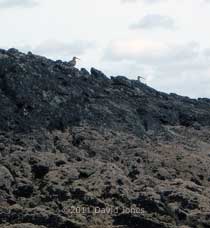Go to the last entry on this page .....Go to previous entry8 May - mybitoftheplanet has moved to its Cornish 'home' - for a couple of weeks. After a pleasantly uneventful journey along quiet roads, we arrived on the Lizard peninsula in brilliant afternoon sunshine and settled into the bungalow that will be our Pinetrees base. With everything unpacked by the end of the afternoon I had the time to stand in the only relatively clear spot on top of the Cornish hedge in front of the bungalow and watch the Swifts dashing back and fore, really close below me in the field beyond.
After dark it was the turn of the bats (species unknown) to flit past the bungalow - in fact the loft of our bungalow is the home for a colony.
Just one picture from the journey - a Lime Hawkmoth. Measuring 5cm across in this pose, it was resting not on a tree (Lime or otherwise) but a rubbish bin in south Somerset!
Very strong southerly winds will mean at least a few days before there's any prospect of launching the kayak, but hopefully they will mean some interesting beach combing.
9 May - Another beautiful Lizard day. The wind has eased and there is a lot more blue sky than cloud.
At least there was the rocky shore to wander along! There were plenty of signs to show how much of a battering the cove took during the easterly winds last week.
And down at Lizard Point there is the debris of the south-westerly gales that followed, with Polpeor Cove absolutely covered with seaweed. While there is still quite a swell affecting passing shipping, the sea has obviously calmed down a great deal - It's a pity we missed the storm! The thought of launching from that slipway, directly into a south-westerly storm makes me shudder...
The warmth of today's afternoon sunshine meant that we were able to sit outside for a meal at the Polpeor Cafe. Before the end of the 19th century this was the site of the first lifeboat station. That boat would have been rowed out to any ship in distress having first been man-handled down the very steep slope to the cove. It seems that when there was a very bad storm the crew needed to crawl around the bend (that is beyond the cafe in this picture) to avoid being blown over the cliff.
Having come down here a bit earlier than usual, we are going to miss the fledging of the Choughs this year. Their eggs hatched around a week ago and so my only chances to see the adults will be when they bring food for their offspring. Those arrivals and departures are usually rather rushed affairs so there may not be many photo-opportunities. With quite a strong wind blowing in off the sea I didn't expect to see too many flying insects about so when I took a short walk along along the first bit of coastal path to the west of the Point I took my little Olympus.
It was clearly finding it difficult to approach its burrow and when it paused in sheltered spots I had a chance to take a few photographs to show the pollen on the pollen combs on its hind legs. I hope to get higher resolution pictures during the holiday. While I didn't see any butterflies along the cliff top section of the path, when I got to the set of steps that takes the path down into what is known as Pistil Meadow, butterflies were active in the more sheltered conditions.
I saw two species during a short pause on the steps. The first was a Common Blue. A species that made its first appearance in our garden a couple of weeks ago, it looked far more spectacular as it fed at Thrift flowers and opened its wings towards the bright sunshine.
The second type was the Small Copper, with a few examples fluttering about. These were much more difficult to approach, with any suspicion of a shadow enough to make them take to the air. Notice that while the top two are quite drab and well worn, one with its bright orange colouring is possibly a freshly emerged individual.
In the summer months I see lots of beetles on plants, but not today. On this short walk I spotted just two examples of this iridescent blue species.
I couldn't decide if the Thrift plants provided a hunting or feeding site for this digger wasp. This one looks like Larra anathema. That species doesn't actually dig a burrow, instead laying its egg in a mole cricket that it first paralyses with its sting. Once the egg is laid the cricket wakes up again and continues to live, even with the egg/larva inside it.
And finally a bird photograph. While at Lizard Point we see lots of Cormorants, often flying past the Point just above the wave tops. However, the conditions today seemed to encourage them to fly higher, some passing high over us rather than over the water.
10 May - A mainly sunny day with winds that are now closer to westerly, and for us (mainly me!) a rest day at the bungalow. I've already mentioned the Swallows that nest somewhere nearby. However, so far this week I have seen no sign of the House Martins that I expect to see at Pinetrees - during our Spring visits they are usually well into with their nesting activities, the nests often built under the eves of the bungalows. We are a bit earlier than usual this year, but I would have expected them to be here by now.
While they appear every Spring their numbers do not seem to increase. Pat (the owner) doesn't mow this area until after the Orchids have finished flowering, but perhaps the need to cut the grass may come too soon for the Orchids to seed successfully.
Also flowering at the moment, and in much larger numbers are the Bugles (Ajuga reptans) which certainly seem to attract the Common Carder Bees.
I see that the Three Cornered Garlics are at more or less the same stage as ours at home - our plants usually flower later.
11 May - The weather continues to treat us well, with lots of sunshine and no rain so far this week.
Today the calm waters off Porthallow were too much of a temptation and I launched the kayak for the first trip of the holiday. The band of grey cloud in this photograph was more the exception rather than the rule!
Porthallow has a great view across Falmouth Bay, and once the kayak and associated bits have been 'put away' we can relax and watch the boat traffic heading in and out of Falmouth. The harbour limits extend out to cover much of the bay and every day ships come and go, with quite a few dropping anchor in the bay as they use the port as a filling station (bunkering) and a pick up point for stores, crew etc, or just wait for orders from their owners. One thing in particular defeats us as we watch - just how far away are the ships?! We know that the nearest point on the opposite coast is St Anthony Head, with its white painted lighthouse which is about 9.3km (5.77 statute miles) from Porthallow Beach. However, judging where a ship is in relation to that point is proving a real challenge.
These ships were both at anchor, and I photographed them with the same lens. Both images have been cropped top and bottom but both show the full width of the frame. The ship in the top picture, Thor Galaxy, appeared to the left of the lower vessel, which is called Eagle Hope.
Eagle Hope is clearly much closer - close enough to get a reasonably clear photograph of it.
Its cargo includes at least ten boats as far as I can tell. We also saw a ship carrying boats when we were here last year.
When we get home I shall look up the sizes of both ships and try to do some maths based on those figures and the image sizes - perhaps that will give some sort of estimate at least of their distances from us.
12 May - The dry weather continues, although the westerly breeze is quite chilly and there was more cloud.
After yesterday's paddling we headed to Lizard Point today for a more relaxing day. A couple of times it looked as though we would get rain but it didn't materialize, and this boat was bathed in sunshine as it headed east past the Point.
Last week's stormy weather may be all but forgotten, but its effect is still clear down in Polpeor Cove where the pebble beach remains covered with a layer of decomposing seaweed which is turning the edge of the sea an orange colour!
13 May - A day when the forecast was for showers in the afternoon and evening - it remained dry with more sunshine than cloud once again, and I headed out on the kayak for another couple of hours. In this picture you can see the Eagle Hope on the horizon. Some ships can remained anchored for quite a long time. I'm hoping that will be the case for this ship. Before the end of the holiday, if the weather remains good I hope to be able to kayak as far as the Coast Watch station at Nare Point. If I do, I'll see if they can give me the ship's exact position.
On the same theme, Sheila and I tried a simple experiment as we watched a ship heading into Falmouth. I was on shore about 1km away from Sheila and she told me by radio as the bow of the ship crossed in front of St Anthony lighthouse. I took a photograph of it at that moment - from my point of view the bow still a long was from the lighthouse. We repeated the process as the lighthouse became visible again behind the ship's stern. Back at the bungalow it was a case of drawing a couple of lines on a chart to match our differing observations, giving a distance from the beach to the ship of around 5.5km at that moment. An interesting exercise although of limited reliability!
In one respect our holiday is badly timed in that we are experiencing neap times at the moment because this is no good for rock-pooling, but along with the present calm conditions it is good for paddling into the small caves along the bit of coast from Porthallow. And bigger tides will occur next week.
14 May - A cool, breezy day down at Porthallow, but some sunshine and the sea calm I headed out on the kayak again. From Porthallow I headed north along the coast with the hope that I could get as far as the Nare Point Coast Watch station where I would ask the volunteers there about the position of the Eagle Hope. The shelter of the steep coastline provided shelter for most of the journey. However, three quarters of the way there, as I rounded Nare Head the coast drops away towards Nare Point, meaning that there was less protection from the winds, and I decided the north-westerly winds were too strong so I turned back.
Instead, I headed in to a bit of the coastline that I don't think I've set foot on previously, and it provided an interesting surprise.
While the caves that I visit (much nearer Porthallow) have roofs made out of a conglomerate layer above massive rocks that form their walls, here there is an area of rock clearly made up of a breccia, with angular rock fragments tightly packed together to form a very hard rock -a sign of the huge geological forces that helped create the complex structure of the Lizard peninsular. On another trip I may take a closer look to see if this breccia extends far to the north of this spot - I haven't seen it back towards Porthallow.
I have a copy of 'An Introduction to the Geology of Cornwall' (R. M. Barton) which emphasises how complex the geology of the Lizard really is. Nothing about it is simple but it seems that the area around Porthallow marks a boundary between the granites etc of the southern section of the peninsular and slightly metamorphosed sedimentary rocks (called killas) to the north. The breccia in the photograph is part of what is known as the Meneage Breccia, possibly produced as the Lizard rocks were thrust against the killas to the north. A geological map in the book shows the Meneage Breccia extending right from the North side of Porthallow Cove all the way to Nare Head, but this is the first time I've come across such a clear example of a breccia.
There haven't been many birds to enjoy on the kayaking trips so far this holiday, apart from the pair of Swans that seem to regard Porthallow as home (they were also here last year) a couple of Mallards that made a brief appearance, a few Cormorants and a single Oystercatcher. However, today as I rounded some rocks I looked up and saw the long curved beaks of a pair of Curlews, and instead of flying off, they stayed put wile I grabbed my camera for a couple of shots that certainly do not do them justice.
With the distance to the Eagle Hope continuing to puzzle us, we tried another range finding exercise when it was time to leave Porthallow. First, I photographed the ship and the distant coastline behind it from the beach, and then took another photograph from the cliffs above the next bay to the south, Porthkerris. I know I could have used a compass to get the bearings, but the small one I have with me isn't the best for getting accurate readings - I must bring a better one next time. Back at the bungalow, and with the help of satellite images obtained from Google Earth last year, in each photograph I identified the point on the coastline that lay behind the mast at the bow of the ship. These, along with the gps coordinates of where the pictures were taken allowed me to draw two intersecting lines on a chart that suggested that the ship was between 4-4.5 km away from Porthallow. - if only I had made it to Nare Point!
Click on images to see larger version
|
|

